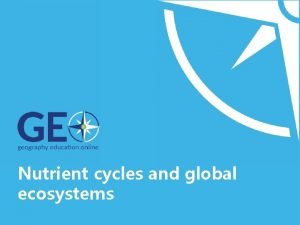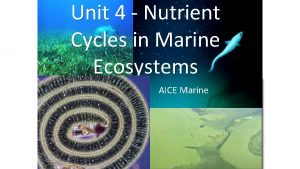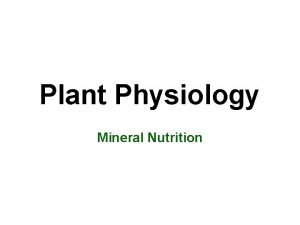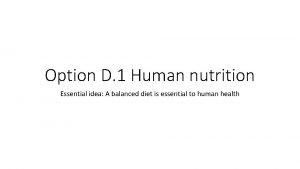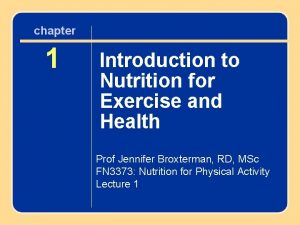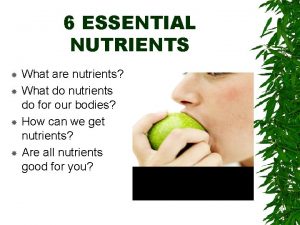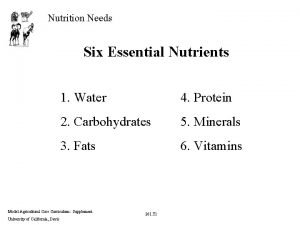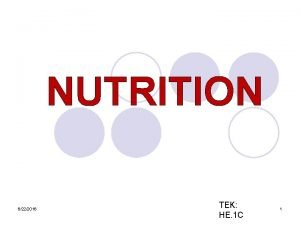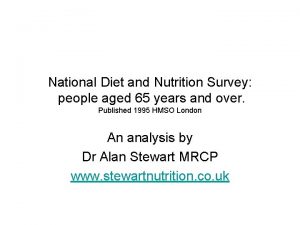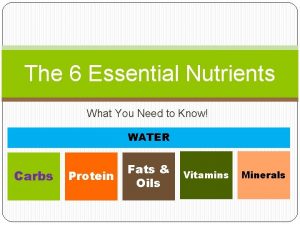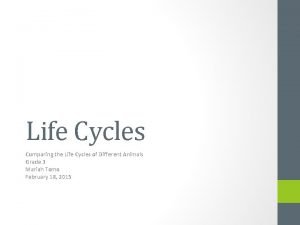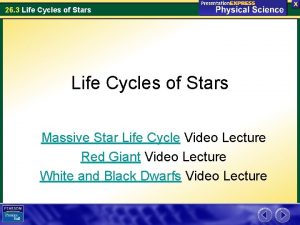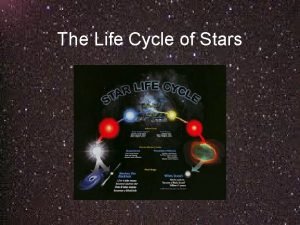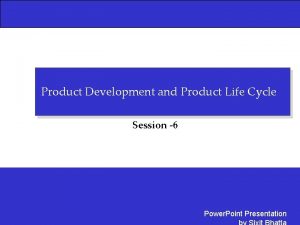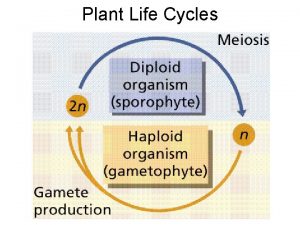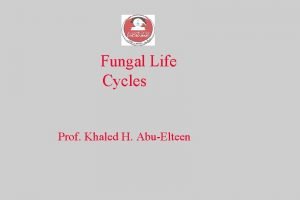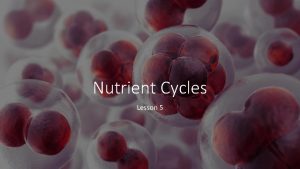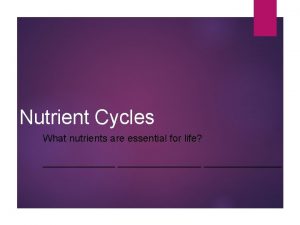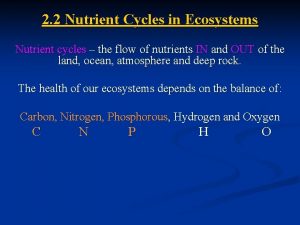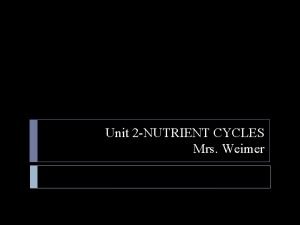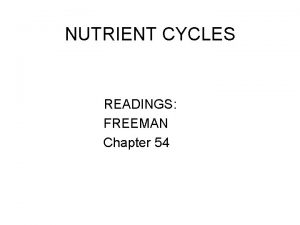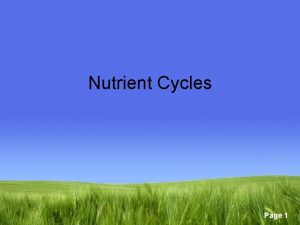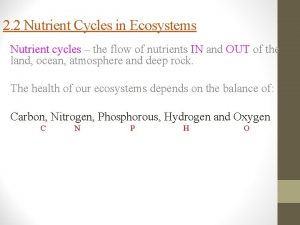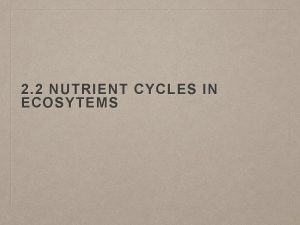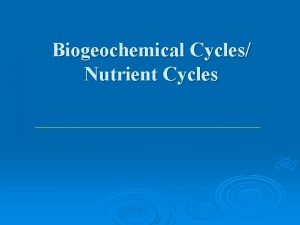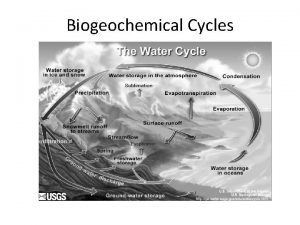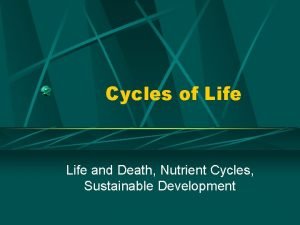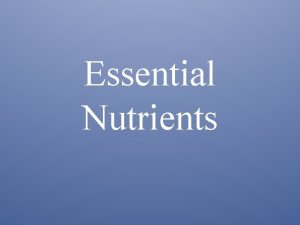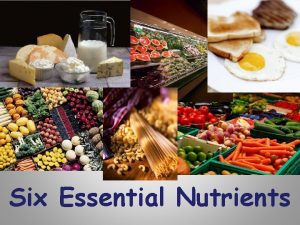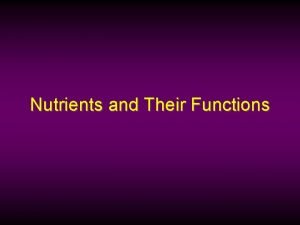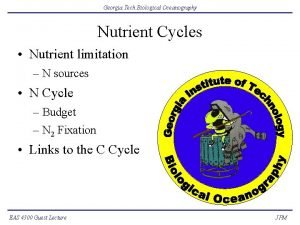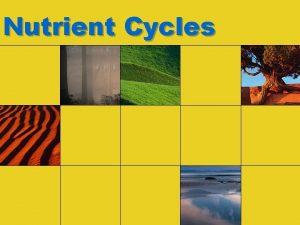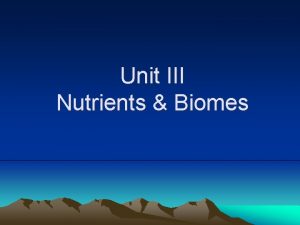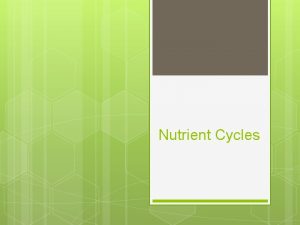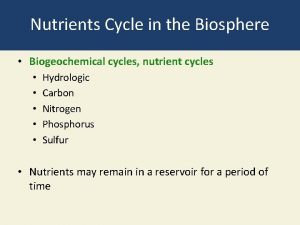Nutrient Cycles What nutrients are essential for life























- Slides: 23

Nutrient Cycles What nutrients are essential for life? CARBON NITROGEN PHOSPHORUS

Carbon cycle Carbon is the most abundant element on earth, it moves through the earth’s spheres in many forms Carbon dioxide (CO 2) gas moves from ATMOSPHERE and BIOSPHERE and back again through photosynthesis and CELLULAR respiration CO 2 also moves back to the atmosphere when organisms DIE and their BODIES decompose CO 2 continually leaves the atmosphere when it is DISSOLVED into the hydrosphere where it then becomes available to aquatic organisms



Stored Carbon In WOODY tissues of long-living TREES Carbon dissolves in the OCEANS which act as a huge RESERVOIR for carbon In slowly decomposing organisms that become deeply buried in the GROUND This is the carbon that becomes FOSSIL FUELS -COAL, OIL AND NATURAL GAS

Human impact Amount of CO 2 USED in photosynthesis and GIVEN OFF by respiration is the same so CO 2 is balanced However, when we BURN trees, coal, oil, natural gas for fuel, the carbon stored in these sources is RELEASED into the air as CO 2 gas This upsets the balance We also have cut down many trees for houses, cities, agriculture, furniture and paper so there are fewer trees that can use the extra CO 2 for photosynthesis

Human impact Extra CO 2 builds up in the AIR and helps trap HEAT in the atmosphere CO 2 gas adds to GLOBAL warming (an increase in the average temperature of the earth’s surface) and CLIMATE change (a long-term change in earth’s climate) Climate change can be caused by natural factors and is accelerated BY HUMAN ACTIVITY

Greenhouse Affect - - Various greenhouse gases in troposphere trap escaping INFRARED radiation from the sun (heat energy) Such as CO 2, H 20 (WATER VAPOUR), CH 4, CFC’s, N 2 0 This is a NATURAL process Human activities put MORE of these gases into atmosphere INCREASING the amount of heat absorbed in atmosphere



Human Activities influencing Green House Gases in Atmosphere

Effects of excess Carbon Earth’s surface temperature has increased between 0. 56 o. C and 0. 92 o. C in the past 100 years Small change but big deal because Earth’s climate is a system So a change is one aspect (temperature) result in changes to other aspects such as precipitation levels, WIND patterns, storm severity LIST EXAMPLES THAT FOLLOW!

IMPACT OF CLIMATE CHANGE AND/OR GLOBAL WARMING


Severe Storms Cat. 5 Hurricane Tropical Storm Cyclone Tornado

Watch Video: Keeping up with Carbon Task read additional notes Handout • Complete questions that follow • Use your notes/handout/internet

Nitrogen cycle Ø Nitrogen is used by organisms to make PROTEINS Ø It makes up 78% of the air but most living things can’t use nitrogen (N 2) gas from the air Ø Plants get nitrogen from THE SOIL after it has been changed to forms that plants can use such as NITRATES. Ø Special BACTERIA in the soil can change nitrogen into usable forms so plants can absorb the nutrients through their roots.


Phosphorus cycle Phosphorus is used by organisms as they GROW AND DEVELOP - In DNA and ATP When rocks are broken down due to WEATHERING and erosion, phosphorus is released into the soil and water Plants ABSORB the phosphorus and animals obtain it when they eat the plants or other animals that eat the plants Usable forms of phosphorus are PHOSPHATES DECOMPOSERS return phosphorus to the soil and water as they break down dead organisms

Phosphorus cycle

Human impact on Nitrogen and Phosphorus Cycles We dramatically increase nitrogen in the atmosphere by burning FOSSIL FUELS These substances mix with water in clouds to produce ACID RAIN- HNO 3 Farmers and gardeners use FERTILIZERS (which contain nitrates and phosphates) to enhance the GROWTH of their plants but not all the nutrients in the fertilizers are used and some stays in the SOIL. When the soil is watered or it rains, excess nutrient are carried by RUN-OFF to ponds, rivers, lakes, oceans which can cause an OVERGROWTH OF ALGAE (Eutrophication) and death of many aquatic organisms.

content/uploads/201 1/02/Eutrphication. jp ghttp: //www. wheatle yriver. cawcontent/uploads/201 1/02/Eutrphication. jp g

Human impact Phosphates are also found in CLEANING PRODUCTS SUCH AS LAUNDRY DETERGENT Human WASTE contains high levels of phosphorus MINING of phosphorus from deep underground rocks increases available phosphorus
 Insidan region jh
Insidan region jh Indicator media
Indicator media Apes nutrient cycles
Apes nutrient cycles Whats a nutrient cycle
Whats a nutrient cycle Nutrient cycles in marine ecosystems
Nutrient cycles in marine ecosystems Arbuscular mycorrhizal fungi
Arbuscular mycorrhizal fungi Non-essential nutrients
Non-essential nutrients Essential vs nonessential nutrients
Essential vs nonessential nutrients Non-essential nutrients
Non-essential nutrients Dri
Dri What are 6 essential nutrients
What are 6 essential nutrients Six essential nutrients
Six essential nutrients Six classes of food
Six classes of food Classification of essential nutrients
Classification of essential nutrients 6 essential nutrients
6 essential nutrients Alliteration words for cycle
Alliteration words for cycle Rvguev suicide
Rvguev suicide How many eggs do kiwis lay
How many eggs do kiwis lay Life cycle of a star assessment
Life cycle of a star assessment Life cycle of a star
Life cycle of a star Style fashion and fad life cycles
Style fashion and fad life cycles Plant life cycles and alternation of generations
Plant life cycles and alternation of generations Fungal life cycles
Fungal life cycles Metaphase ii
Metaphase ii



